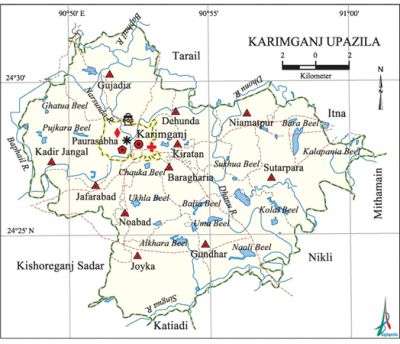Karimganj Upazila
Karimganj Upazila (kishoreganj district) area 200.52 sq km, located in between 24°22' and 24°32' north latitudes and in between 90°48' and 91°01' east longitudes. It is bounded by tarail and itna upazilas on the north, nikli, katiadi and kishoreganj sadar upazilas on the south, Nikli and mithamain upazilas on the east, Kishoreganj Sadar upazila on the west.
Population Total 258266; male 129134, female 129132; Muslim 252559, Hindu 5519, Buddhist 10 and others 178.
Water bodies Main rivers: Narsunda, Bathail, Singua, Dhanu; Balia, Naoli, Bara, Kolai, Alkhara' and Ukhla beels are notable.
Administration Karimganj Thana was formed in 1909 and it was turned into an upazila in 1983.
| Upazila | ||||||||
| Municipality | Union | Mouza | Village | Population | Density (per sq km) | Literacy rate (%) | ||
| Urban | Rural | Urban | Rural | |||||
|
1 |
12 |
85 |
196 |
17260 |
241006 |
1288 |
48.9 |
34.9 |
| Upazila Town | ||||||||
|
Area (sq km) |
Mouza |
Population |
Density |
Literacy rate (%) | ||||
|
6.21 |
3 |
17260 |
2779 |
48.9 | ||||
| Union | ||||
| Name of union and GO code | Area (acre) | Population | Literacy rate (%) | |
| Male | Female | |||
|
Karimganj 69 |
1535 |
8711 |
8549 |
44.20 |
|
Kadir Jangal 60 |
5580 |
16031 |
16489 |
34.14 |
|
Kiratan |
1409 |
4790 |
4927 |
38.63 |
|
Gujadia 34 |
6542 |
17443 |
17869 |
38.03 |
|
Gundhar 25 |
6558 |
11336 |
10955 |
28.38 |
|
Joyka 51 |
6407 |
15528 |
15054 |
33.04 |
|
Jafarabad 43 |
2390 |
6781 |
6976 |
34.20 |
|
Dehunda 17 |
2397 |
9613 |
9974 |
35.47 |
|
Niamatpur 77 |
2792 |
11210 |
10944 |
39.35 |
|
Noabad 86 |
2841 |
10525 |
10962 |
29.53 |
|
Baragharia 08 |
2861 |
9389 |
9545 |
39.05 |
|
Sutarpara 94 |
7051 |
7777 |
6888 |
28.73 |
Source Bangladesh Population Census 2001, Bangladesh Bureau of Statistics.
Archaeological heritage and relics Darbar House at Jangalbari Fort of isa khan (sixteenth century), Isa Khan Shahi Mosque (sixteenth century), ruins of residence of Isa Khan including the boundary wall.
Historical events Isa Khan, chief of the Bara Bhuiyans, surprised Jangalbari and occupied it defeating the Koch King Laksman Hajo. Isa Khan established his residence at Jangalbari. During the war of liberation in 1971, encounters were held between the freedom fighters and the Pak army at different places like Kajla, Aiela, Sakura, Baliabari. Karimganj was liberated on 16 December.

Religious institutions Mosque 286, temple 8, tomb 5, akhra 2.
Literacy rate and educational institutions Average literacy 35.8%; male 39.0%, female 32.7%. Educational institutions: college 3, secondary school 17, primary school 116, satellite school 4, madrasa 15. Noted educational institutions: Jangalbari English School (1862).
Newspapers and periodicals Defunct periodical: Suchana (1981), Shadhin Barta (1998), Isha Khan (1988-1991), Shahoser Padabali (1992).
Cultural organisations Club 39, cinema hall 1, theatre stage 1, theatre group 10, shilpakala academy 1, playground 19, women's organisation 1, children park 1.
Main sources of income Agriculture 61.03%, non-agricultural labourer 3.32%, industry 1.03%, commerce 17.23%, transport and communication 4.40%, service 3.49%, construction 1.31%, religious service 0.27%, rent and remittance 0.25% and others 7.67%.
Ownership of agricultural land Landowner 51.80%, landless 48.20%; agricultural landowner: urban 38.67% and rural 52.75%.
'Main crops Paddy, jute, wheat, mustard, nut, garlic, chilli, onion, tomato, vegetables.
Extinct or nearly extinct crops Sesame, sugarcane, motor, aman paddy.
Main fruits Mango, black berry, jackfruit, banana, plum, papaya, litchi, olive.
Fisheries, dairies and poultries Fishery 25, dairy 37, poultry 467, hatchery 1.
Communication facilities Pucca road 36.80 km, semi-pucca road 1.85 km, mud road 510.55 km.
Extinct or nearly extinct traditional transport Palanquin, bullock cart.
Noted manufactories Rice mill, flour mill, saw mill, ice factory, oil mill, bakery, candle factory, various' workshop.
Cottage industries Goldsmith, blacksmith, weaving, potteries, bamboo work, cane work, wood work, tailoring.
Hats, bazars and fairs Hats and bazars are 38, fairs 10, most noted of which are Karimganj Bazar, Babur Hat, Marichakhali Hat, Murikandhi Hat.
''Main exports Paddy, jute, vegetables, mustard, garlic, chilli, onion, banana, bamboo and cane items.
Access to electricity All the wards and unions of the upazila are under rural electrification net-work. However 15.40% of the dwelling households have access to electricity.
Sources of drinking water Tube-well 95.84%, tap 0.13%, pond 0.50% and others 3.53%.
Sanitation 23.56% (rural 21.52% and urban 52.44%) of dwelling households of the upazila use sanitary latrines and 58.89% (rural 60.57% and urban 35.14%) of dwelling households use non-sanitary latrines; 17.55% of households do not have latrine facilities.
Health centres Upazila health complex 1, satellite clinic 1, health and family welfare centre 7, community clinic 33.
Natural disasters The floods of 1974, 1998 and 2004 caused heavy damages to settlements, livestock and other properties of the upazila.
NGO activities Operationally important NGOs are brac, Annesa. [Md Rezaul Habib Reza]
References Bangladesh Population Census 2001, Bangladesh Bureau of Statistics; Cultural survey report of Karimganj Upazila 2007.
